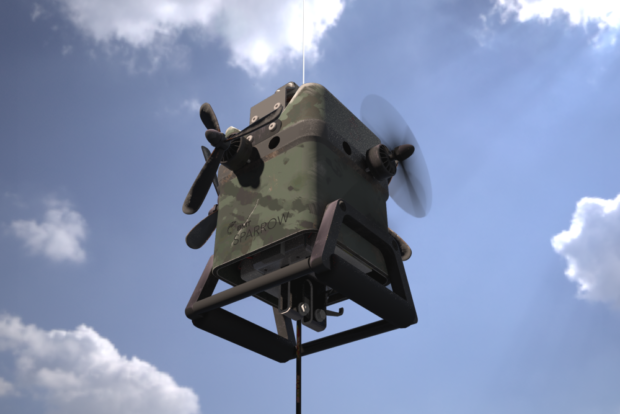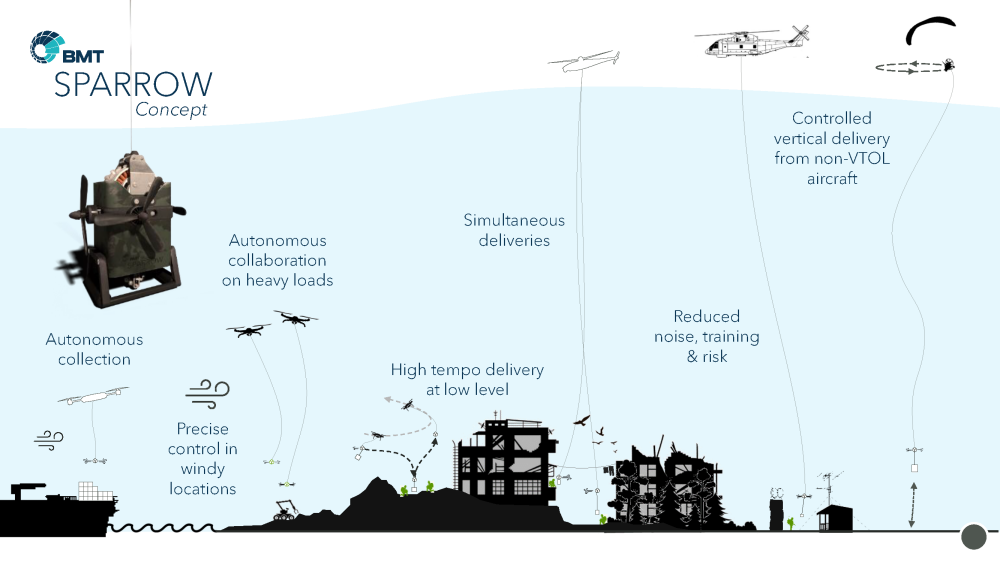BMT, an international design, engineering, science, and risk management consultancy, has announced that it has been granted a patent by the U.K. Intellectual Property Office for a novel concept called ‘SPARROW’, an autonomous ‘air-ground payload transfer device’ with truly disruptive capabilities for drone delivery applications.
Phil Metcalfe, Regional Business Director for UK and Europe, commented:
“BMT’s patent signals a new type of suspended robotic device: a device that takes over responsibility for the final moments of payload delivery, and better suited to challenging and sensitive environments. This small, highly-ruggedised robotic device could even autonomously collect packages as well as deliver them without the need for infrastructure on the ground.
“With the development of this autonomous and highly-versatile concept the project team have delivered a great example of how BMT actively applies its innovation to solve its customers’ complex problems,” added Metcalfe.
“Further, we were super excited to participate in the British Army’s “Army Warfighting Experiment” (AWE) 23, with our rugged technology demonstrating the potential to feed into the army’s plans for a future ‘digital backbone,” concluded Metcalfe.
This month, the AWE 23 independent Product Assessment Report cited the following:
“As the system is developed further, it will provide a capability unlike anything else known to Defence. It would enable the use of UAS to deliver payloads in the most challenging terrain, reducing risk to both the airframe, the payload and personnel on the ground.”
With SPARROW, BMT has addressed the inherent problem of large, noisy, and potentially hazardous delivery drones having to land or hover low over the payload destination, potentially close to people in unpredictable, sensitive and cluttered environments.
SPARROW is fundamentally different to winch systems commonly used in current trials for delivery drones. On a winch, the payload swinging at the bottom end of a line is raised or lowered by the cable drum attached to the underside of the fuselage, and moved horizontally by subtle movements of the drone above. This provides poor control of the payload, especially in windy conditions and limits the maximum height of the drone. In comparison, SPARROW is located at the bottom end of the line with the payload with its own power, sensors and actuators; it has autonomous control of its descent using an internal drum, while making precise and immediate horizontal adjustments to counter wind effects using 4 small, quiet pusher fans. SPARROW takes responsibility of the delivery allowing the larger delivery drone to remain much, much higher at the destination, relatively unheard and unobtrusive at ground level.
Being much smaller than the drone and without the need for powerful, lift-generating rotors, SPARROW is perfect for safe, precise and quiet delivery in challenging or sensitive environments.
BMT’s development partner, Dr Steve Wright from Wright Airborne Computing, commented:
“During 30 years of working in aerospace, I have not seen anything like the surge in new aircraft, systems, and applications that has happened in the last five years. SPARROW is a perfect example of this revolution, fuelled by a happy convergence of 21st century technologies harnessed together by computers and software that engineers like me could only dream about 30 years ago.”.
Background
The SPARROW concept was initially developed by a team at BMT for defence applications where drones are being trialled to resupply troops and deliver items such as sterilised medical equipment to dispersed, unpredictable, and potentially hostile locations. Still early in its development, SPARROW was selected by the UK Ministry of Defence for the highly competitive annual flagship innovation event called the ”Army Warfighting Experiment”. The world-first demonstration took place in HM Naval Base Portsmouth, UK, in November 2022 with the associated ”Exploitation Event” in February 2023.
Problem solved
A logistics drone with any significant carrying capacity must also carry heavy, high-capacity batteries to provide the required range, and have powerful rotors to generate the required lift. The drone unavoidably becomes large, noisy and potentially dangerous. In drone delivery trials, the drone itself has to descend and fly amongst the buildings and ground clutter to land at the destination or winch the payload down from a low hover. This produces high levels of noise and requires predictable open spaces, clear of people, animals and obstructions or risks damage to the drone and anything that comes into contact with it. In a military context, limiting delivery to open spaces in a hostile environment also increases the vulnerability of both the drone and receiving personnel due to enemy action. The only alternative, dropping the payload by parachute, is unacceptably hazardous, inaccurate and risks getting caught on trees, wires and buildings.
The ideal solution would offer the full payload capacity of a large, powerful drone without the associated noise and risk to people on the ground, while also offering a precise, safe, reliable delivery.
BMT’s solution
Replacing a traditional drone-mounted winch, BMT’s novel robotic device solves this problem by using a ‘system of systems’ approach. The autonomous SPARROW lowers both itself and the payload at the bottom end of a long, low-profile, weight-bearing line, with the top end of the line attached to the drone above. To provide autonomy of movement, SPARROW has an internally powered cable drum to silently control height, four small side-facing pusher fans for horizontal adjustments, and all the necessary sensors, power, and processing.
Benefits to the end-user/operator
The SPARROW concept enables the large, noisy, vulnerable drone to remain much higher above the complex ground environment at the destination. Just how high depends on the use case; safe controlled delivery is possible using this approach from 200ft in windy conditions, and 500-1000 ft in light winds, with additional options for higher drops. In comparison to using a traditional winch from a low hover, a SPARROW delivery offers a much smaller, quieter physical presence and a safer, more precise delivery to a wider variety of locations, including confined spaces close to vertical surfaces and urban infrastructure.
What next for BMT’s solution
Alongside applications in Defence, the approach may also offer value to manned helicopter operations and across other sectors such as Maritime Ship-Shore deliveries, support to maintenance engineers on tall structures, Emergency Services, and e-commerce deliveries to domestic addresses. The project is looking to partner for further Research and Development and licence the technology to a range of leading established operators.
If development of the experimental platform proves successful, BMT is offering a glimpse of an alternative future in which the environment is not filled by the incessant noise of drones buzzing around at low level in close proximity to people, but one where drones remain safely at height, out of sight, out of earshot and out of mind.
Source: Press Release


